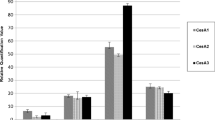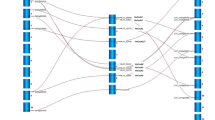Abstract
Genetic improvement of cellulose biosynthesis in woody trees is one of the major goals of tree biotechnology research. Yet, progress in this field has been slow owing to (1) unavailability of key genes from tree genomes, (2) the inability to isolate active and intact cellulose synthase complexes and, (3) the limited understanding of the mechanistic processes involved in the wood cellulose development. Here I report on the recent advances in molecular genetics of cellulose synthases (CesA) from aspen trees. Two different types of cellulose synthases appear to be involved in cellulose deposition in primary and secondary walls in aspen xylem. The three distinct secondary CesAs from aspen—PtrCesA1, PtrCesA2, and PtrCesA3—appear to be aspen homologs of Arabidopsis secondary CesAs AtCesA8, AtCesA7, and AtCesA4, respectively, based on their high identity/similarity (>80%). These aspen CesA proteins share the transmembrane domain (TMD) structure that is typical of all known “true” CesA proteins: two TMDs toward the N-terminal and six TMDs toward the C-terminal. The putative catalytic domain is present between TMDs 2 and 3. All signature motifs of processive glycosyltransferases are also present in this catalytic domain. In a phylogenetic tree based on various predicted CesA proteins from Arabidopsis and aspen, aspen CesAs fall into families similar to those seen with Arabidopsis CesAs, suggesting their functional similarity. The coordinate expression of three aspen secondary CesAs in xylem and phloem fibers, along with their simultaneous tension stress-responsive upregulation, suggests that these three CesAs may play a pivotal role in biosynthesis of better-quality cellulose in secondary cell walls of plants. These results are likely to have a direct impact on genetic manipulation of trees in the future.
Similar content being viewed by others
References
Delmer, D. P. (1999), Annu. Rev. Plant Physiol. Plant Mol. Biol. 50, 245–276.
Brown, R. M. Jr., Saxena, I.M. and Kudlicka, K. (1996), Trends Plant Sci. 1, 149–156.
Delmer, D. P. and Amor, Y. (1995), Plant Cell 7, 987–1000
Haigler, C. (1985), in Cellulose Chemistry and Applications, Nevell, T. P. and Zoronian, S. H., eds., Ellis Horwood, Chichester, UK, pp. 30–83.
Timell, T. E. (1986), Compression Wood in Gymnosperms. Springer-Verlag, Berlin, Germany.
Kimura, S., Laosinchai, W., Itoh, T., Cui, X., Linder C.R., and Brown, R.M. (1999), Plant Cell 11, 2075–2085.
Haigler, C. and Blanton, R. L. (1996), Proc. Natl. Acad. Sci. USA 93, 12,082–12,085.
Saxena, I. M., Lin, F. C., Brown, R. M. (1990), Plant Mol. Biol. 15, 673–683.
Saxena, I. M., Brown, R. M., Fevre, M., Geremia, R. A., and Henrissat, B. (1995), J. Bacteriol. 177, 1419–1424.
Pear, J. R., Kawagoe, Y., Schreckengost, W. E., Delmer, D. P., and Stalker, D. M. (1996) Proc. Natl. Acad. Sci. USA 93, 12,637–12,642.
Richmond, T. A. (2000), Genome Biol. 1(4), Rev. 3001.1–3001.6.
Taylor, N. G., Scheible W.-R., Cutler, S., Somerville, C. R., and Turner, S. R. (1999), Plant Cell 11, 769–779.
Holland, N., Holland, D., Helentjaris, T., Dhugga, K., Xoconostle-Cazares, B., and Delmer, D. P. (2000), Plant Physiol. 123, 1313–1323.
Taylor, N. G., Laurie, S., and Turner, S. R. (2000), Plant Cell 12, 2529–2540.
Joshi, C. P. (2003), in Molecular Genetics and Biotechnology of Forest Trees, Kumar, S. and Fladung, M., eds., Howarth, Howarth, NY.
Dadswell, H. E. and Wardrop, A. B. (1955), Holzforschung 9, 97–103.
Norberg, P. H. and Meier, H. (1966), Holzforschung 20, 174–178.
Timell, T. E. (1969), Svensk Papperstidning 72, 173–181.
Wu, L., Joshi, C. P., and Chiang, V. L. (2000), Plant J 22, 495–502.
Kawagoe, Y. and Delmer, D. P. (1997) in Genetic Engineering, vol. 19, Setlow, J. K., ed., Plenum, New York, NY, pp 63–87.
Fagard, M., Desnos, T., Desprez, T., Goubet, F., Refregier, G., Mouille, G., McCann, M., Rayon, C., Vernhettes, S., and Hofte, H. (2000), Plant Cell 12, 2409–2424.
Arioli, T., Peng, L., Betzner, A. S., Burn, J., Wittke, W., Herth, W., et al. (1998), Science 279, 717–720.
Author information
Authors and Affiliations
Corresponding author
Rights and permissions
About this article
Cite this article
Joshi, C.P. Xylem-specific and tension stress-responsive expression of cellulose synthase genes from aspen trees. Appl Biochem Biotechnol 105, 17–25 (2003). https://doi.org/10.1385/ABAB:105:1-3:17
Issue Date:
DOI: https://doi.org/10.1385/ABAB:105:1-3:17




